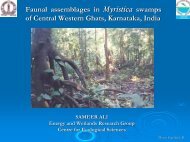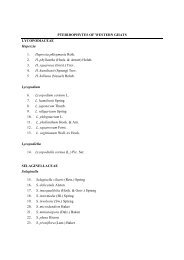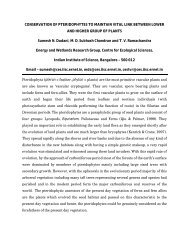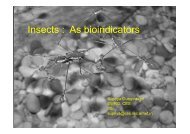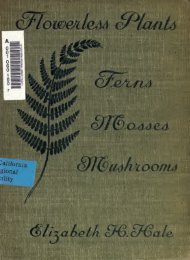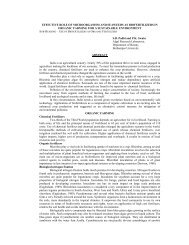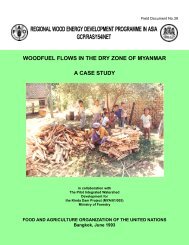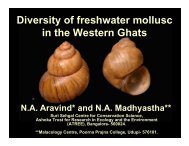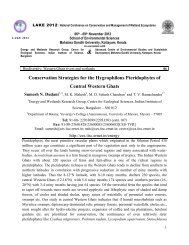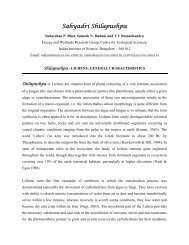The diatom genus Gomphonema Ehrenberg in India: Checklist and ...
The diatom genus Gomphonema Ehrenberg in India: Checklist and ...
The diatom genus Gomphonema Ehrenberg in India: Checklist and ...
You also want an ePaper? Increase the reach of your titles
YUMPU automatically turns print PDFs into web optimized ePapers that Google loves.
Fig 1. Map show<strong>in</strong>g the area of <strong>in</strong>vestigation (<strong>in</strong>set <strong>India</strong> with Bedthi River bas<strong>in</strong> highlighted).<br />
have only a s<strong>in</strong>gle species (Conservation International, 2008). <strong>The</strong> fauna <strong>and</strong> flora<br />
of this region has attracted attention of systematic <strong>and</strong> evolutionary biologists because<br />
of the mixture of high-level endemism (Inger, 1999; Myers et al. 2000) <strong>and</strong> various<br />
aff<strong>in</strong>ities with other biogeographic regions (Bossuyt & Mil<strong>in</strong>kovitch, 2001).<br />
In the present report we have compiled a checklist of the <strong>Gomphonema</strong> taxa previously<br />
reported <strong>and</strong> described from <strong>India</strong> (Table 1). We also document <strong>and</strong> describe with<br />
light <strong>and</strong> scann<strong>in</strong>g electron microscopy three new species of <strong>Gomphonema</strong> from<br />
Central Western Ghats, Karnataka State, <strong>India</strong>. We also present <strong>in</strong>formation about<br />
each species' autecology, with particular attention paid to water chemistry <strong>and</strong><br />
seasonality.<br />
Materials <strong>and</strong> methods<br />
Ten first to fourth order streams were surveyed for <strong>diatom</strong>s <strong>and</strong> water quality assessment <strong>in</strong> the Bedthi<br />
River Bas<strong>in</strong>, Central Western Ghats, Karnataka (Fig. 1) from January to December, 2006. Diatom<br />
samples were collected by vigorously scrubb<strong>in</strong>g 3–5 stones from the substratum with a toothbrush <strong>and</strong><br />
the resultant suspension was preserved <strong>in</strong> ethanol. A portion of sample was oxidized by the hot HCl<br />
<strong>and</strong> KMnO 4 method (Taylor et al. 2007). Cleaned material was mounted onto glass slides with<br />
213



